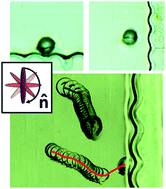Colloids in confined liquid crystals: a plot twist in the lock-and-key mechanism†
Abstract
By confining soft materials within tailored boundaries it is possible to design energy landscapes to address and control colloidal dynamics. This provides unique opportunities to create reconfigurable, hierarchically organized structures, a leading challenge in materials science. Example soft matter systems include liquid crystals. For instance, when nematic liquid crystals (NLCs) are confined in a vessel with undulated boundaries, bend and splay distortions can be used to position particles. Here we confine this system in a twist cell. We also study cholesteric liquid crystals, which have an “intrinsic” twist distortion which adds to the ones imposed by the solid boundaries. The cholesteric pitch competes with the other length scales in the system (colloid radius, vessel thickness, wavelength of boundary undulations), enriching the possible configurations. Depending on the pitch-to-radius and pitch-to-thickness ratios the interaction can be attractive or repulsive. By tuning the pitch (i.e. changing the concentration of the chiral dopant), it is possible to selectively promote or inhibit particle trapping at the docking sites.



 Please wait while we load your content...
Please wait while we load your content...